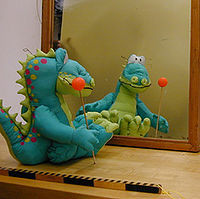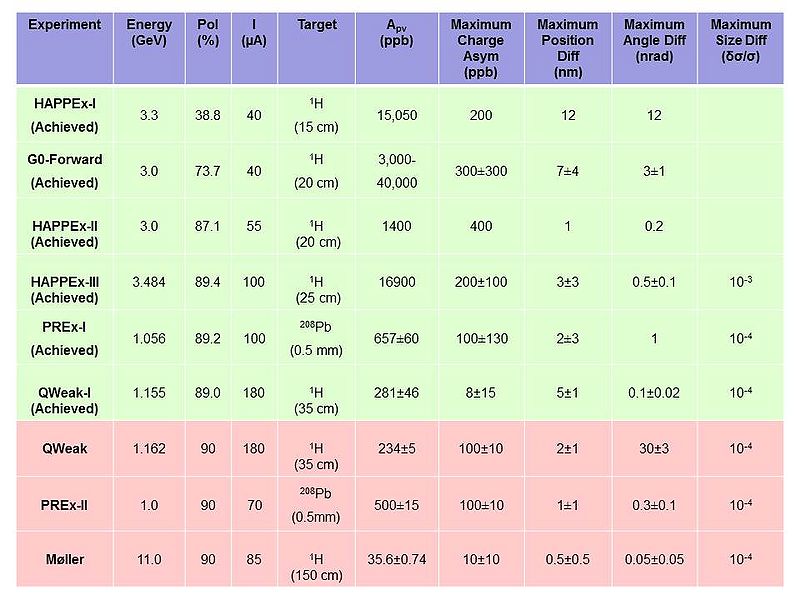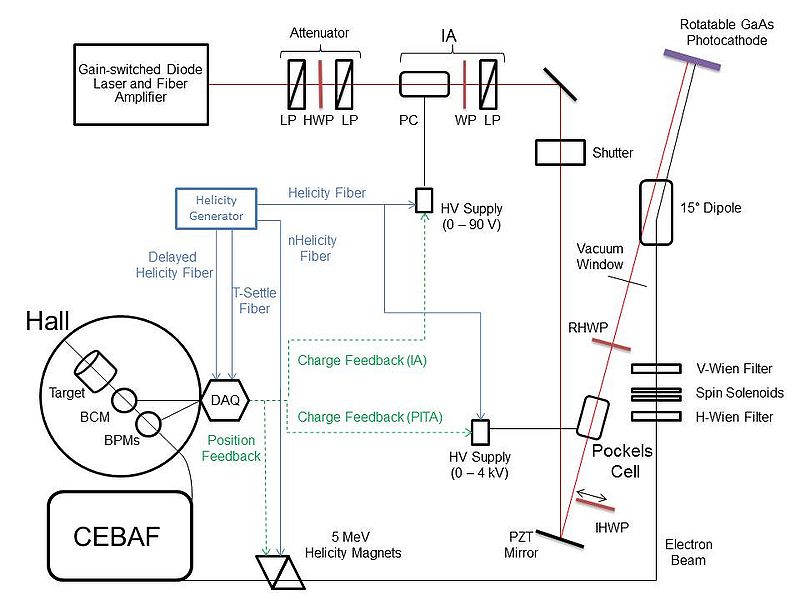Difference between revisions of "Parity Quality Beam"
(→G0 PQB) |
|||
| Line 202: | Line 202: | ||
| + | =='''Other Presentations'''== | ||
| + | * Parity Violation Experiments at CEBAF Beam Specifications, Matt Poelker, March 4, 2004: [[media:parity_table_2004.ppt]] | ||
| + | * G0 Collaboration Meeting August 16, 2002: [[media:g0_collab_aug16_2002.pdf]] | ||
Revision as of 17:06, 31 May 2014
A significant portion of the experiments performed at Jefferson Lab require a polarized electron beam. A subset of these are parity violation experiments which have exceptionally stringent requirements on the quality of the electron beam. As the sign of the electron beam helicity reverses at the target of the experiment no other measurable quantity of the electron beam may change. This includes the beam intensity, polarization, position, angle, energy or spot size.
To ensure this beam quality, a significant effort occurs at the polarized electron source, where the laser beam and electron photogun combine to produce the intended electron beam. Also significant is the ability to accelerate the beam to high energy while transporting it to the experimental target, all while maintaining a parity quality electron beam (PQB).
Parity Violation
Discussion of parity violation can be found at NIST: The Fall of Parity: [1]
Parity Violation Experiments
- JLab Hall A Parity Experiments (HAPPEX, PREX, C-REX, PVDIS): [2]
- JLab Hall C G0 Experiment: [3]
- JLab Hall C QWeak Experiment: [4]
- JLab Hall A Moller Experiment: [5]
- Mainz A4 Experiment: [6]
- The following table lists what have been achieved and the future requirements on PQB: media:jlab_parity_table.pdf media:jlab_parity_table.pptx
Selected References
- Experimental Test of Parity Conservation in Beta Decay. C. S. Wu et al., Phys. Rev. 105 (1957) 1413 media:PhysRev.105.1413.pdf
- Parity-Violating Electron Scattering and the Electric and Magnetic Strange Form Factors of the Nucleon. D. S. Armstrong and R. D. McKeown, Annu. Rev. Nucl. Part. 62 (2012) 337 media:annurev-nucl-102010-130419.pdf
Injector PQB Setup
- SLAC's polarized electron source laser system and minimization of electron beam helicity correlations for the E-158 parity violation experiment. T. B. Humensky et al., Nucl. Instr. and Meth. A 521 (2004) 261 media:NuclInstrMethA.521.261.pdf
- Helicity correlated asymmetries caused by optical imperfections. K. Aulenbacher, Euro. Phys. J. A 32 (2007) 543 media:EuroPhysJA.32.543.pdf
QWeak PQB
Accelerator Meetings
- Accelerator PQB Meeting August 13, 2009: media:PQB_Meeting_13Aug09.pdf media:PQB_Meeting_13Aug09.pptx
- Accelerator PQB Meeting March 24, 2009: media:PQB_Meeting_24March09.pdf media:PQB_Meeting_24March09.pptx
B-Team Presentations
- B-Team PQB Presentation October 28, 2009: media:B-Team_PQB_28Oct09.pdf media:B-Team_PQB_28Oct09.ppt
- B-Team PQB Presentation May 13, 2009: media:B-Team_PSSNoise_13May09.pdf media:B-Team_PSSNoise_13May09.ppt
- B-Team PQB Presentation April 29, 2009: media:B-Team_PQB_29April09.pdf media:B-Team_PQB_29April09.ppt
- B-Team PQB Presentation December 3, 2008: media:B-Team_PQB_03Dec08.pdf media:B-Team_PQB_03Dec08.ppt
- B-Team PQB Presentation October 9, 2008: media:B-Team_PQB_09Oct08.pdf media:B-Team_PQB_09Oct08.ppt
Collaboration Presentations
- QWeak Collaboration Meeting September 17, 2010: media:QWeak_Coll_17Sep10.pdf media:QWeak_Coll_17Sep10.pptx
- QWeak Collaboration Meeting May 24, 2010: media:QWeak_Coll_24May10.pdf media:QWeak_Coll_24May10.pptx
- QWeak Collaboration Meeting February 1, 2010: media:QWeak_Coll_01Feb10.pdf media:QWeak_Coll_01Feb10.pptx
- QWeak Collaboration Meeting February 1, 2010: media:QWeakInjTeam_01Feb10.pdf media:QWeakInjTeam_01Feb10.pptx
- QWeak Collaboration Meeting November 8, 2009: media:QWeak_Coll_08Nov09.pdf media:QWeak_Coll_08Nov09.pptx
- QWeak Collaboration Meeting November 8, 2009: media:QWeakInjTeam_08Nov09.pdf media:QWeakInjTeam_08Nov09.pptx
- QWeak Collaboration Meeting July 17, 2009: media:QWeak_Coll_17Jul09.pdf media:QWeak_Col_17Jul09.pptx
- QWeak Collaboration Meeting November 18, 2008: media:QWeak_Coll_18Nov08.pdf media:QWeak_Coll_18Nov08.pptx
Other Presentations
- OPS Parity Training August 5, 2009: media:parity_Ops_Training_05Aug09.pdf media:parity_Ops_Training_05Aug09.pptx
- S&T Review July 14, 2009: media:S&T_Review_2009.pdf media:S&T_Review_2009.pptx
- PAVI09 June 22 2009: media:PAVI09_suleiman.pdf media:PAVI09_suleiman.ppt
Technical Developments
Discussion of technical developments in preparation for the QWeak experiment:
Jefferson Lab injector development for next generation parity violation experiments. J. Grames, J. Hansknect, M. Poelker, R. Suleiman, Hyperfine Interactions 201 (2011) 69 media:HyperfineInter.201.69.pdf
- Schematic of Jefferson Lab Injector setup: media:jlab_source_PV2.pdf media:jlab_source_PV2.pptx
Two-Wien Slow Helicity Reversal
- Two Wien Filter Spin Flipper. J. Grames et al., Part. Accel. Conference (PAC’11), New York, NY, (2011) media:tup025.pdf
New Helicity Board
- A new helicity board was built for the QWeak experiment: media:NewHelBoardDesign.pdf media:NewHelBoardDesign.pptx
- More details can be found in the User's Guide: media:NHBUserGuide.pdf media:NHBUserGuide.docx
- The pseudo-random 30-bit Shift Register is shown here (change .txt to .C)
New Pockels Cell HV Switch
- A simple and inexpensive high voltage switch for driving Pockels cells and other low capacitance loads: media:Pockelsswitchposter.pdf media:Pockelsswitchposter.pptx
Electronic Cross-talk & Ground Loop Elimination
- Electronic Cross-talk & Ground Loop Elimination in Injector: media:jlab_source_GroundLoop.pdf media:jlab_source_GroundLoop.pptx
G0 PQB
Lessons Learned
Lessons learned for parity violation experiments at Jefferson Laboratory is an on-going series of meetings between scientists and students from the accelerator and physics division to learn from past experiences and meet new challenges in the field of parity violation experiments:
- Supperlattice SVT4722#2 in Gun3, January 2005:
- Riad's G0 beam studies summary to the MCC 8 AM meeting on February 1, 2005 (PowerPoint)
- Parity Beam Quality Specifications:
- Specifications for Beam Parameters for Happex-II and Happex-He from the Happex Collaboration (PS)
- Beam Parameter Specifications for the G0 Experiment from the G0 Collaboration (PS)
- Preliminary Beam Specification Parameters for the Qweak Experiment from Roger Carlini (PDF and MS-Word)
- Lessons Learned Part 1 November 18, 2004 - Meeting minutes are here.
- Phase Trombone for HAPPEX-2 from Alex (PDF)
- Parity Lessons Learned from Chao (PDF)
- Parity Quality Beam Development and Experiment Timeline from Matt (MS-Word)
- Aligning the Pockels cell - the HAPPEX procedure (MS-Word)
- Comments about Helicity Effects for G0 and HAPPEX from Mark (PDF or PowerPoint)
- Injector Setup for G0 and HAPPEX from Reza (Powerpoint)
- Lessons Learned Part 2 December 9, 2004 - Meeting minutes are here.
- G0 slide regarding beam loading from Kaz (PDF and PowerPoint)
- Augmented version of slides from Mark for Part 1 meeting (PDF or PowerPoint)
- HAPPEX presentation from Kent (PDF or PowerPoint)
- Here is Chao's report on recent beam studies (PDF)
- Lessons Learned Part 3 January 13, 2005:
- Matt's meeting outline (Word).
- Chao showed injector matching results from December (PDF).
- Riad's summary of Injector Studies Using Superlattice Photocathode, January 13, 2005 (PPT).
G0 Backward Angle Run 2006
- Meetings:
- Hall C Beam Line Planning Meeting, February 8, 2005
- G0 Accelerator Planning Meeting, November 1, 2005
- Accelerator Commissioning Meeting, February 27, 2006
- Documents:
- Beam Parameter Specifications for G0 Backward Angle Run, 10/7/05 (PDF)
- Hall C:
- Modification of Hall C Moller polarimeter spectrometer (Q1)
- Modification of Hall C quadrupole configuartion (3C18-20)
- Hall C safety platform for cyrogenic can access
- HKS beamline deinstallation
- HKS spectrometer degaussing
- Hall C Halo and G0 girder installation
- Hall C beam dump integrity
- Accelerator:
- Polarized source setup
- Parity quality beam measurement and feedback systems
- Injector matching at low beam energy
- Accelerator operation at low beam energy
- Extraction to two halls at low beam energy (summer '06)
Other Presentations
- Parity Violation Experiments at CEBAF Beam Specifications, Matt Poelker, March 4, 2004: media:parity_table_2004.ppt
- G0 Collaboration Meeting August 16, 2002: media:g0_collab_aug16_2002.pdf
Need to copy from webpage:
- G0 Backward Angle Run
- JLab Gun Group G0 experiment homepage
- Quick links to useful slides and talks:
- Parity Violation Experiments at CEBAF Beam Specifications (PPT), Matt Poelker, March 4, 2004


